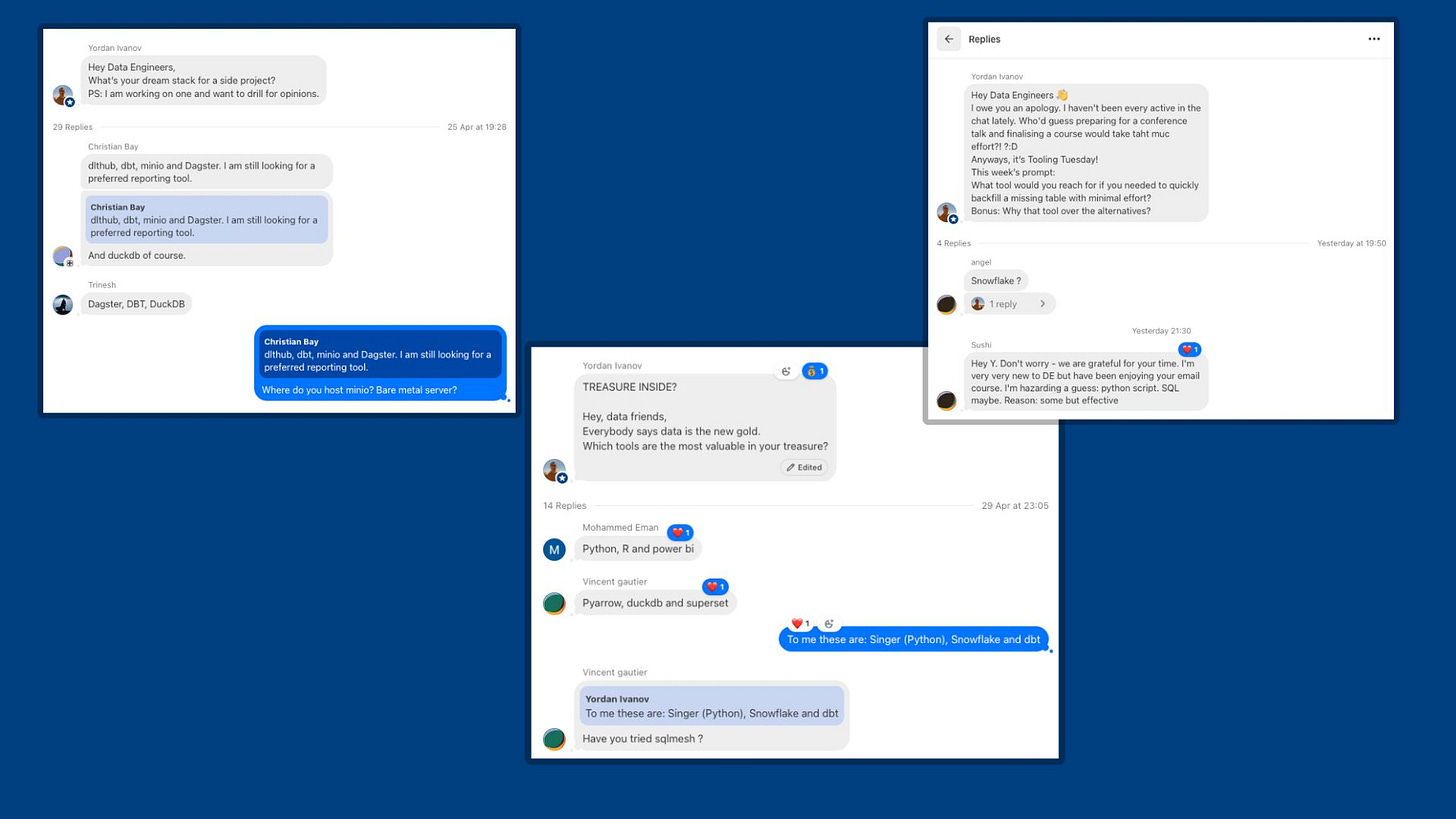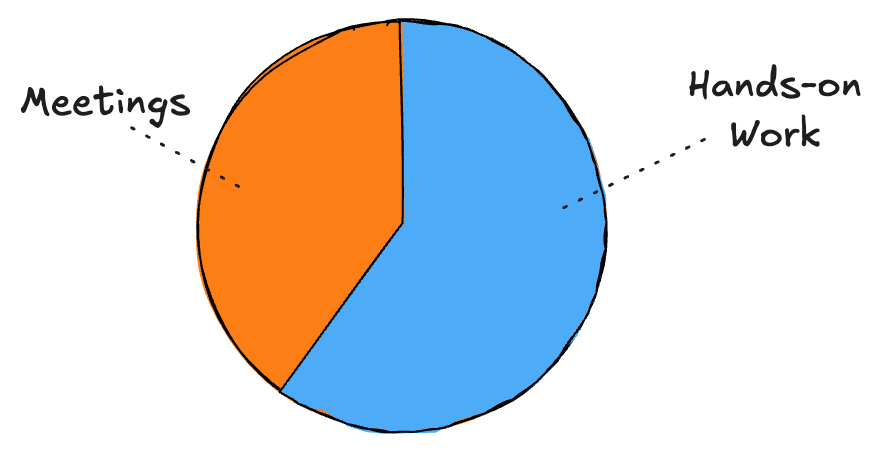The Week of a Head of Data Engineering
Here’s how my week looks and what you can expect if you want to become a head of data
Greetings, Data Engineer,
Every ambitious data engineer strives to close the skill gap and position themselves for the next step in the career ladder.
But sometimes, a role is not what you thought. And the best way to understand if a role would fit you well is to know how you’d spend your time doing that role.
That’s why I wrote this article. Today, you’ll learn exactly how I, as the Head of Data Engineering, spend my week. I share how much time you’d spend on meetings and hands-on work. You will also learn my pro tips for structuring your week for maximum efficiency.
But wait, that’s not all!
Paying Data Gibberish subscribers can grab my 30-60-90 action plan for aspiring leaders. This Kanban board will teach you in practice how to balance stakeholder relationships and deliver practical tasks.
Enjoy!
Meetings
As the Head of Data Engineering in my org, I am not only responsible for a team of data and analytics engineers. I also need to nurture my relationship with a number of stakeholders.
Here’s what this would mean for you if you want to become a head of data.
You’ll spend about 16 hours a week in recurring meetings. That’s the price of context. Let’s break it down.
Daily Meetings
Team Dailies
If your team is remote-first, you probably already do daily calls. But here’s the twist: you don’t need them to hit your goals. You need them because you’re building a team of actual people, not just ticket machines.
These calls are your chance to catch up, joke around, and recreate the hallway moments that in-office folks take for granted.
Expect to spend about 30 minutes a day, or 2.5 hours a week, on this.
Project-Specific Dailies
You’ll almost always be pulled into at least one cross-functional initiative. Think big, messy, everyone-has-a-stake type of projects. The kind that dies without coordination.
Right now, I’m part of one that’s been rolling for 18 months. We have a dedicated a daily to keep everyone aligned. It follows my team’s daily and adds another 2.5 hours a week.
So, just on daily meetings, you’re looking at 5 hours a week.
Weekly Meetings
Team One-to-Ones
You should spend at least 1 hour a week with each of your direct reports. If your team is lean, this might cover your skip-levels, too.
These aren’t status updates. They’re your team’s space to talk about their work, growth, and anything else that’s on their mind.
You don’t own the agenda. They do. If you’ve got something pressing to say, either give them a heads-up or book a separate session.
And here’s something critical:
Don’t wait for a one-to-one to give feedback. Feedback should be live, not delayed.
I spend 5 hours every week on one-to-one calls with people who report directly or indirectly to me.
One-to-Ones With Your Manager
As a Head of Data Engineering, no one’s managing your career. If you’re doing it right, you’re managing yourself.
But you still need to align with your manager. I spend about 45 minutes a week with my director and another 45 with my VP. We talk strategy, company direction, and how data fits in.
Sometimes I bring a topic that needs deeper exploration. When I do, I book a separate call.
Here are a few I initiated lately:
Rethinking team responsibilities after org changes
Choosing the next-gen data viz tool for internal use
Setting up a real data quality roadmap (not just dbt tests)
That’s 1.5 hours a week for upward syncs.
DnA Weekly Syncs
If you’re part of a broader Data & Analytics function, you’ll have a weekly sync across teams. Ours is a 45-minute slot to cover blockers, share wins, and align on direction.
So, adding it up, your weekly recurring meetings (excluding dailies) will total more than 7 hours.
Other Meetings
Your calendar will always include recurring and unplanned meetings that don’t fit neatly into categories. Here’s what to expect.
Sprint Check-ins
I dislike traditional Scrum processes. However, I appreciate how much working in sprints helps.
If your team sprints, you’ll likely you will have a bi-weekly check-in. These will take you about an hour every other week.
Team Show & Tell Sessions
The DataOps S&T is one of my favourite meetings. Once every other meeting, someone on the team demos something cool: a new Singer tap, a trick they learned, or even a mistake that taught them something.
You can use these meetings to teach your entire team a skill, or on a hands-on workshop.
If you're not doing these yet, start with once a month. Low effort, high morale.
These take at least 60 minutes every other week.
Cross-team Calls
There are loads of calls that fall in the “Others” category:
Stakeholder syncs - Meet your stakeholders for at least 30 minutes biweekly. On average, I spend 45 minutes weekly in these.
Peer syncs - I love these calls. They allow you to dive deeper into what other parts of the data team do. Spend 30 minutes fortnightly with each peer. With 2 peers, my average is 30 minutes a week.
Big room updates - Think of monthly company-wide Town halls, Product updates, and other monthly calls. My average result is 60 minutes a week.
Many believe these are useless, but they are essential to grow strong relationships and learn about things that may impact your work from the source.
So these “Other” can easily take you over 3 hours weekly.
Excluding pair-programming, debugging sessions and other ad-hoc and recurring calls, on average, I spend about 40% of my time in meetings.
Now, let’s talk about what you will do in the remaining 24 hours of your workweek.
Hands-On Work
You don’t get to be the Head and just “delegate the technical stuff.” You’ll lose your edge. And your team will notice.
If you want to keep making good decisions, you have to stay sharp.
Here’s a breakdown of the kind of work you will jump into:
Strategy Work
You own hiring plans, career ladders, and team structure.
You should be constantly asking:
Is the team spending time on the right things?
Are the right people solving the right problems?
Are we operating like a product team or a service desk?
Revisit these occasionally.

Architecture and Tooling
This is where being technical pays off. You’ll design systems or at least review them deeply.
Here are a few things I’ve been working on recently:
What should we use instead of Looker?
Is Airflow good enough for us? What about Mage?
I love Snowflake, but would Iceberg serve us better?
How do we structure everything for better data quality?
Would micro-batching and Kafka work better for us?
You don’t need to code everything. But you do need to understand tradeoffs and spot hidden costs.
This kind of projects are my favourite and I tend to spend the most time here.
Steal my ultimate Snowflake learning guide. Share this article with only 1 of your friends and get this massive resource for free in your inbox.
Tactical Work
This is your “still got it” zone. Use it wisely.
Here’s what I touch regularly:
Pipelines: Writing and reviewing Singer taps.
Infrastructure as Code (IaC): Kubernetes, Terraform and Snowflake setup in code
CI/CD: Jenkins, GitHub Actions, Great Expectations, SQLFluff and stuff
You won’t do this full-time. But you need to be able to jump in, unblock, and model best practices.
Principles
As the Head of Data Engineering, everybody wants to steal your time. It’s your responsibility to protect it.
I treat hands-on work like a project. I block chunks of time for it like I would for meetings.
About two years ago, I wrote an extensive article on how to ensure you stay productive.
Here’s a summary on how to not lose your mind:
Group meetings together: Stack your meetings. Back-to-backs are better than random slots throughout the day.
Block time for tasks: If it’s not on your calendar, it won’t happen. Book your hands-on time.
Avoid distractions: Mute Slack when needed. Don’t make yourself too available. Your team should solve most problems without you.
Check this article if you want to know more in practice.
Final Thoughts
Being Head of Data Engineering isn’t about being a genius. It’s about being useful.
It means context-switching between strategy and SQL. Being able to talk to the CFO about cost savings at 2 PM and fix a broken DAG at 4 PM. Writing a career ladder in the morning and reviewing Terraform in the afternoon.
You need to be low-maintenance, high-output, and comfortable making judgment calls with 70% of the context.
If you want to do high-impact work, this is a great job. Just be ready to build systems, teams, and habits that scale better than your calendar.
Cheers,
PS: Are you serious about stepping into career development? My course my Stakeholder Influence System, is launching in just a few short weeks. Don’t miss the bonuses for early access students.
PPS: Only Paying Data Gibberish members can unlock all the deep dives, mini-courses and resources in the premium content library. Don’t limit your growth. Upgrade your experience.
The Resource
So, if you seriously want to step up and show you can do the job, you need a companion. This is where my extensive action plan for aspiring data leaders comes into play.





